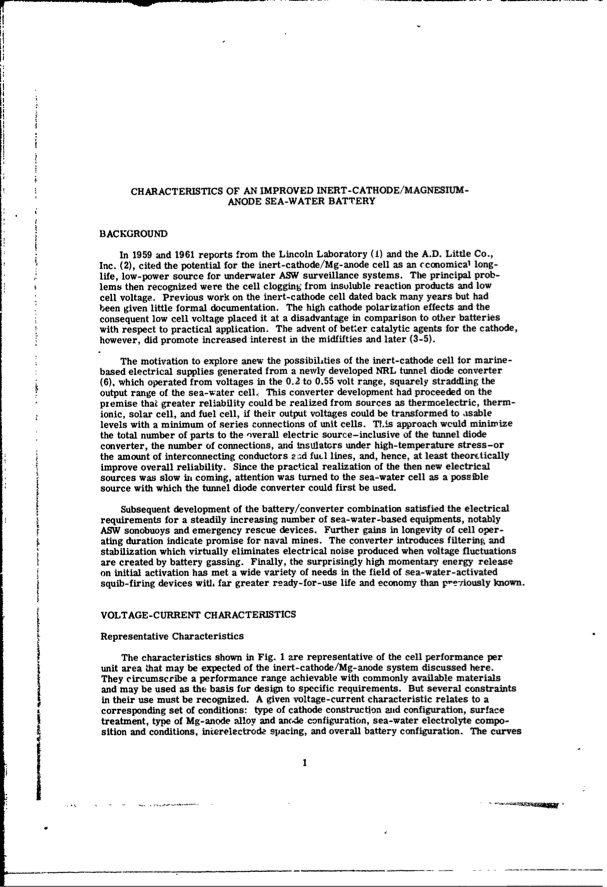
PDF Publication Title:
Text from PDF Page: 004
Ii Ii CHARACTERISTICS OF AN IMPROVED INERT-CATHODE/MAGNESIUM- ANODE SEA-WATER BATTERY BACKGROUND In 1959 and 1961 reports from the Lincoln Laboratory (1) and the A.D. Little Co., Inc. (2), cited the potential for the inert-cathode/Mg-anode cell as an cconomica1 long- life, low-power source for underwater ASW surveillance systems. The principal prob- lems then recognized were the cell clogging from insoluble reaction products and low cell voltage. Previous work on the inert-cathode cell dated back many years but had been given little formal documentation. The high cathode polarization effects and the consequent low cell voltage placed it at a disadvantage in comparison to other batteries with respect to practical application. The advent of better catalytic agents for the cathode, "however,did promote increased interest in the midfifties and later (3-5). The motivation to explore anew the possibilities of the inert-cathode cell for marine- based electrical supplies generated from a newly developed NRL tunnel diode converter (6), which operated from voltages in the 0.2 to 0.55 volt range, squarely straddling the output range of the sea-water cell This converter development had proceeded on the premise that greater reliability could be realized from sources as thermoelectric, therm- ionic, solar cell, and fuel cell, if their output voltages could be transformed to ,ssable levels with a minimum of series connections of unit cells. T•is approach wculd minimize the total number of parts to the nverall electric source-inclusive of the tunnel diode converter, the number of connections, and insulators under high-temperature stress-or the amount of interconnecting conductors 2:d fu*,l lines, and, hence, at least theorctically improve overall reliability. Since the practical realization of the then new electrical sources was slow in coming, attention was turned to the sea-water cell as a possible source with which the tunnel diode converter could first be used. Subsequent development of the battery/converter combination satisfied the electrical requirements for a steadily increasing number of sea-water-based equipments, notably ASW sonobuoys and emergency rescue devices. Further gains in longevity of cell oper- ating duration indicate promise for naval mines. The converter introduces filtering and stabilization which virtually eliminates electrical noise produced when voltage fluctuations are created by battery gassing. Finally, the surprisingly high momentary energy release on initial activation has met a wide variety of needs in the field of sea-water-activated squib-firing devices with, far greater ready-for-use life and economy than pIeviously known. VOLTAGE-CURRENT CHARACTERISTICS Representative Characteristics The characteristics shown in Fig. 1 are representative of the cell performance per unit area that may be expected of the inert-cathode/Mg-anode system discussed here. They circumscribe a performance range achievable with commonly available materials and may be used as the basis for design to specific requirements. But several constraints in their use must be recognized. A given voltage-current characteristic relates to a corresponding set of conditions: type of cathode construction and configuration, surface I1treatment, type of Mg-anode alloy and anc•de configuration, sea-water electrolyte compo- sition and conditions, inierelectrode spacing, and overall battery configuration. The curvesPDF Image | INERT-CATHODE SEA-WATER BATTERY

PDF Search Title:
INERT-CATHODE SEA-WATER BATTERYOriginal File Name Searched:
AD0673399.pdfDIY PDF Search: Google It | Yahoo | Bing
Product and Development Focus for Salgenx
Redox Flow Battery Technology: With the advent of the new USA tax credits for producing and selling batteries ($35/kW) we are focussing on a simple flow battery using shipping containers as the modular electrolyte storage units with tax credits up to $140,000 per system. Our main focus is on the salt battery. This battery can be used for both thermal and electrical storage applications. We call it the Cogeneration Battery or Cogen Battery. One project is converting salt (brine) based water conditioners to simultaneously produce power. In addition, there are many opportunities to extract Lithium from brine (salt lakes, groundwater, and producer water).Salt water or brine are huge sources for lithium. Most of the worlds lithium is acquired from a brine source. It's even in seawater in a low concentration. Brine is also a byproduct of huge powerplants, which can now use that as an electrolyte and a huge flow battery (which allows storage at the source).We welcome any business and equipment inquiries, as well as licensing our flow battery manufacturing.| CONTACT TEL: 608-238-6001 Email: greg@salgenx.com | RSS | AMP |